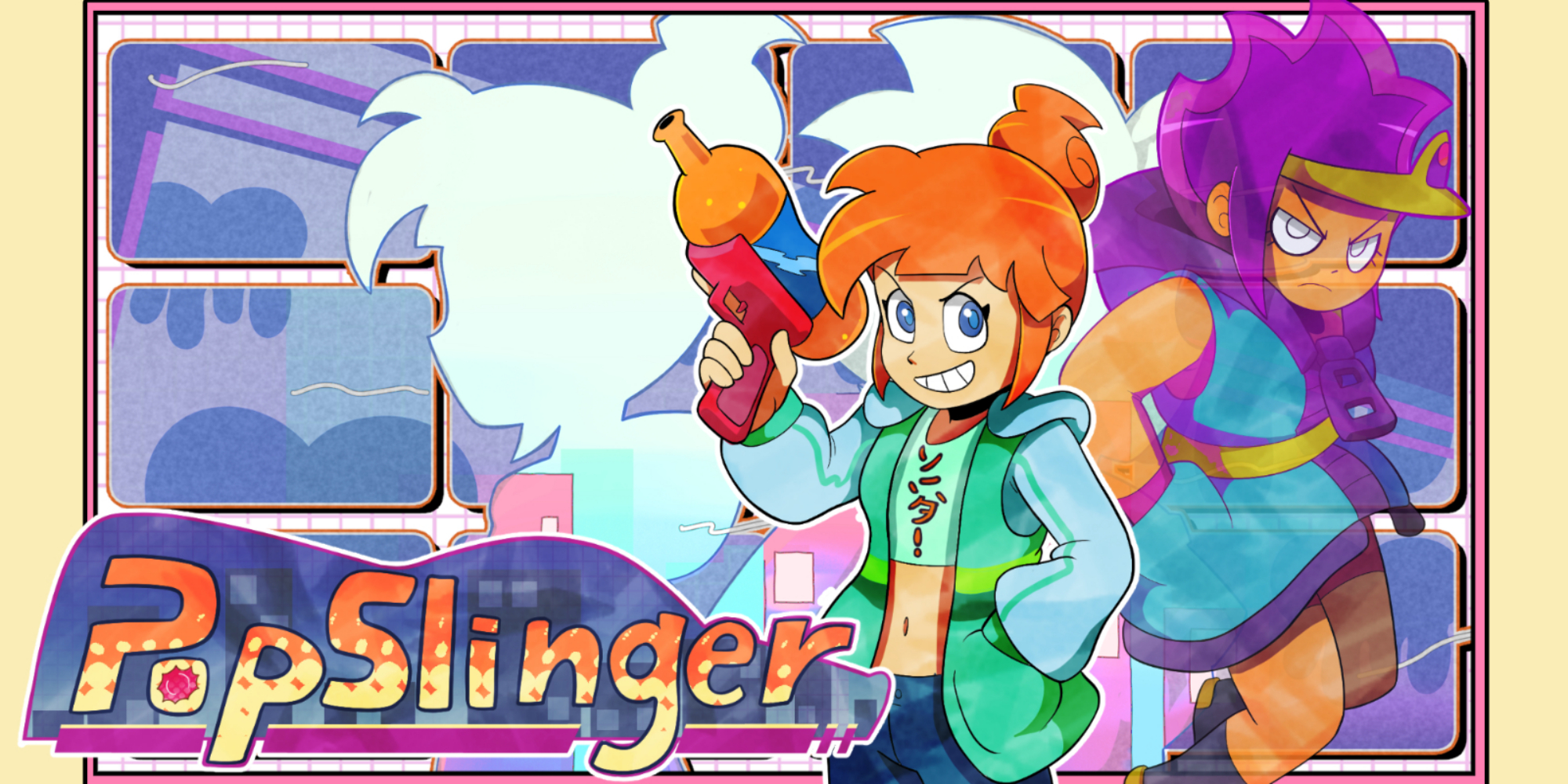We all have certain criteria that need to be met before the hard-fought choice of what to play. The driving element that’ll spur you on to play ‘x’ game instead of another. I can take or leave what kind of gameplay a title has, as long as it has a great story or awesome aesthetics. What piqued my interest in PopSlinger wasn’t so much the 2D side-scrolling beat ’em up, Streets of Rage (or more my jam, Scott Pilgrim Vs. The World: The Game) influence, but rather the bubblegum-infused cartoon style it boasts.
But such is the case for Nicolas Winding Refn’s film, Only God Forgives, audiences had the resounding notion that it was all style over substance. For me? Yeah maybe, but sometimes looking at something cool for 90 minutes is just the right bit of junk food I needed. PopSlinger is that by comparison, even down to the runtime, only maybe a bit too shallow and a bit less visually alluring once you get your hands on it. Let’s get into it.
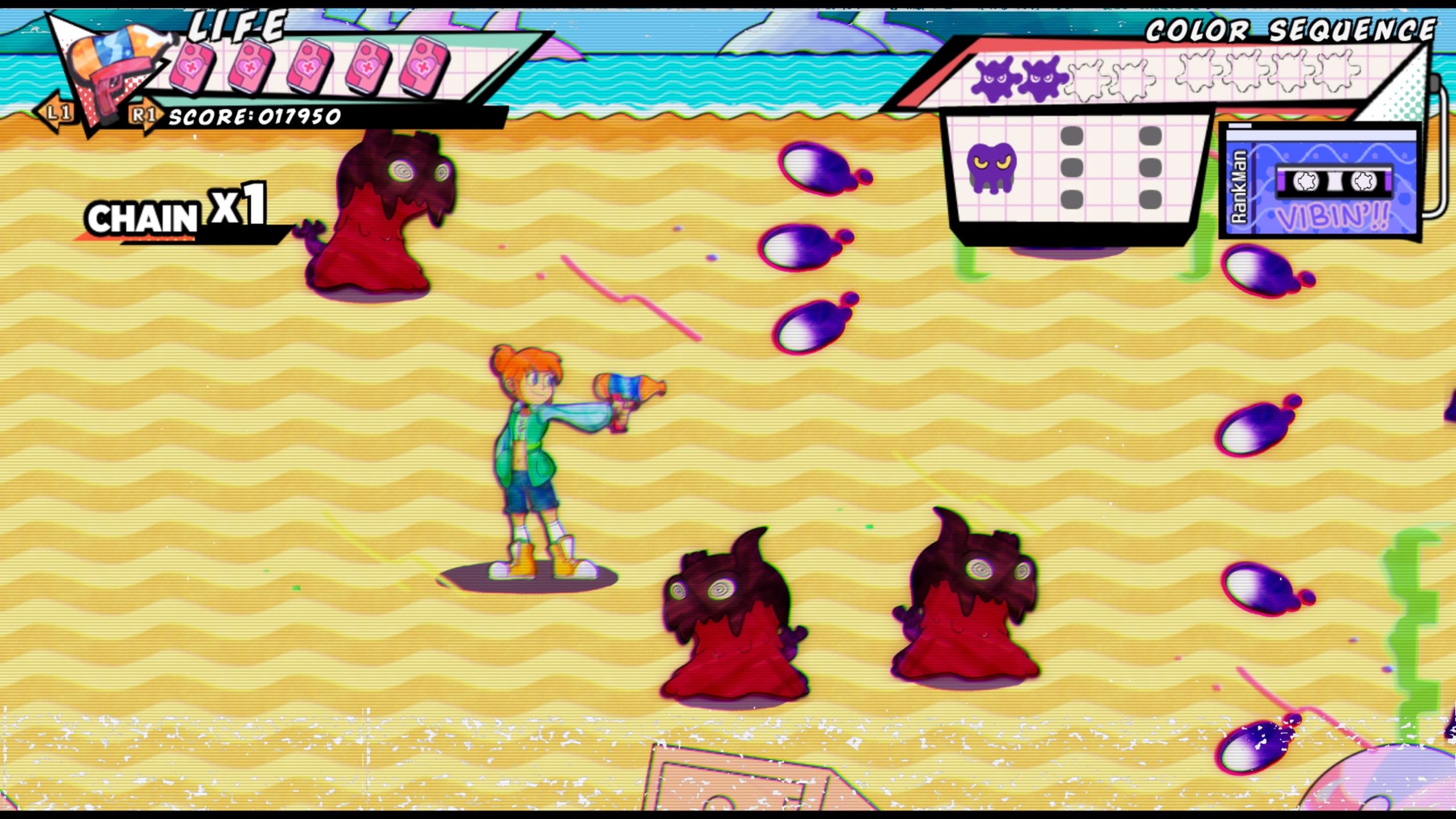
More Professor Peppy Than Dr Pepper
As I mentioned at the top, PopSlinger is essentially a 2D sidescrolling beat ’em up, with a couple of delineating tricks up its sleeve. First of which is the absence of melee combat in favour of a shooting approach. You’ll be going through stages blasting goo monsters with soda-inspired guns, like a Strawberry Shotgun or Cola Rocket. However, the game explains at the beginning that running and gunning is fun, but you’ve got to be more tactile in your approach.
This is because the monsters have their own colour like red, purple and yellow. Defeating one adds to a combo meter and if you get four of the same colour kills in a row, your companion Gin (a spirit I’ll get into later) can perform one of a handful of assists like a turret to stay in place shooting or they can fire on your shot to act as a double hit. This combo meter can go up to 8, so you can do 4 of one colour and 4 of another to get a new and interesting result.
This all sounds quite cool in concept, right? Well, hold on tight to those concepts, because the execution can’t quite match it. The gameplay feels wooden as your character, Ria, has this almost joystick-feeling stop and start to her movement. As well as that, Ria can only fire in front of her, so when the game presents enemies above you in this top-down format, it means you’ll just have to traverse up to them to defeat. It sounds minor when put into words but the surrounding elements exacerbate into something a bit more.
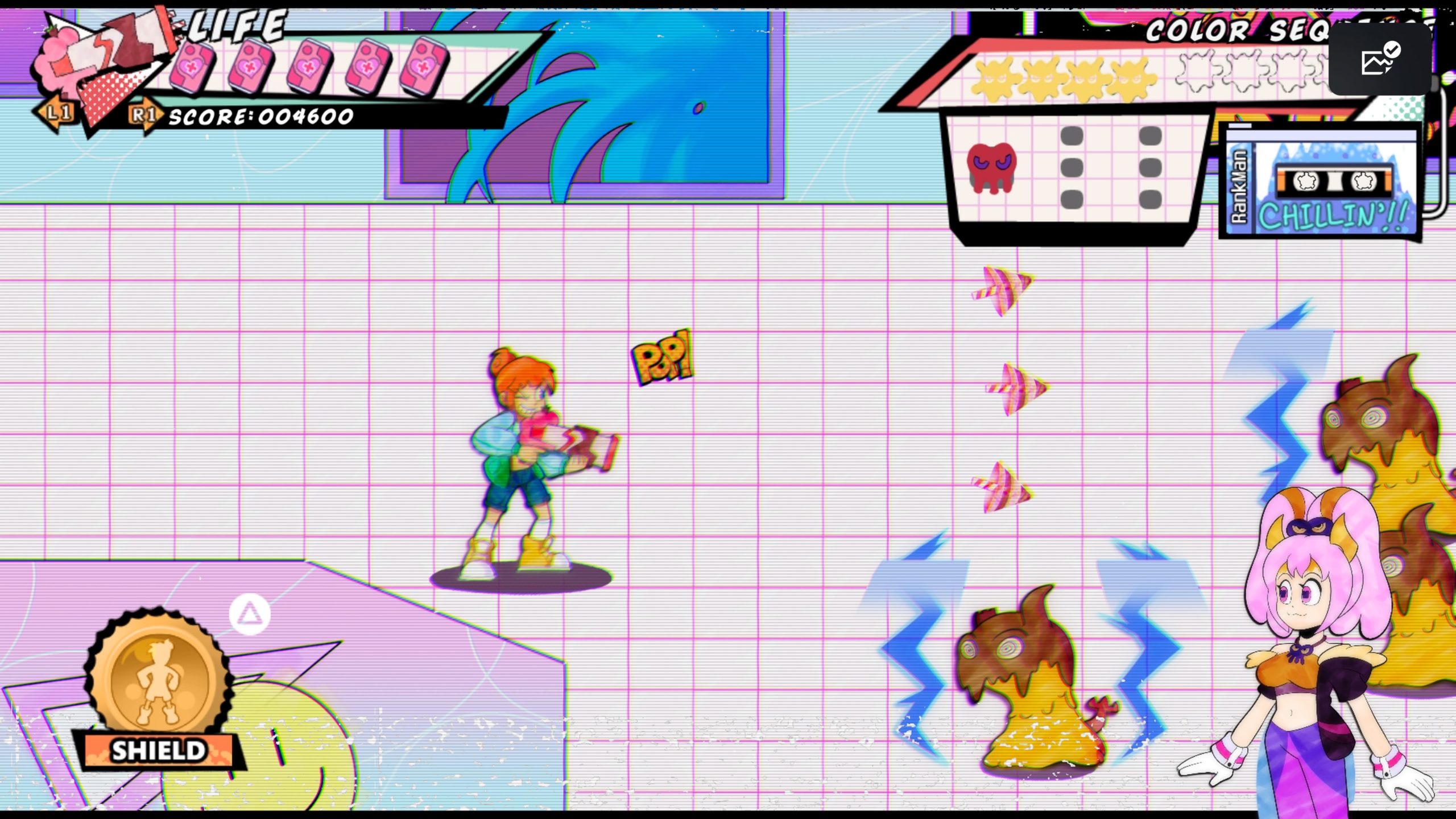
Cracking Open A Can
The camera is way too close to the character, making it difficult to navigate the stage and all of its enemies, especially in the later levels. Enemy spawns aren’t random, but they are weirdly patterned, making pulling off combos harder than necessary as you’ll try and dodge incoming attacks. If you do get hit, that’s the end of your combo and Ria has this almost rectangle hitbox around her character sprite, resulting in frustrating “That so didn’t hit me” moments.
On a more positive note, enemies have that same type of hitbox, making boss encounters pretty exploitable. You do have a dodge, but the animation isn’t fluid and can set you up for a follow-up attack from somewhere else too easily. Matching 8 of the same colour gives you the ability to heal, but enemies can interrupt it, which is easily done because the fighting arenas are tiny.
I also went the extra mile to get said combos because it bumps up the dynamic music on the stage and increases your stage rank from Vibin’, all the way to Poppin’ – giving you what I thought would be a better score. No, I got a couple of Ds on the stages because of that way of playing. Which is fine, beat ’em ups aren’t my forte, so I’ll continue.
But the final level requires you to have at least a rank B to even enter! I packed in shooting coordinating colours (how I was told to play) and instead shot indiscriminately (how I was told not to play), adding to a chain multiplier per kill and that’s how I got better ranks. Can you see how that crumb of a minor inconvenience snowballed into something greater yet?
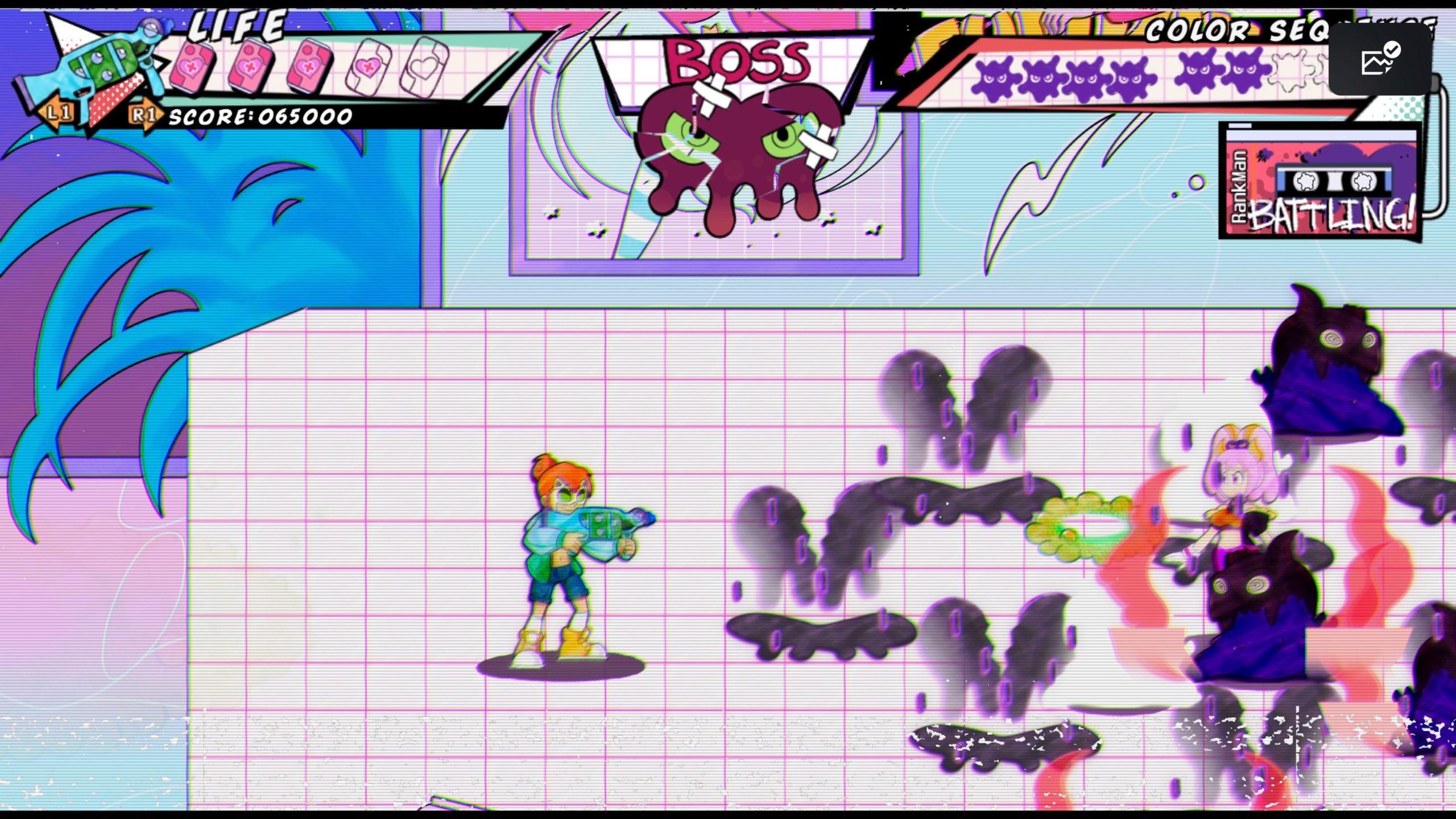
Fizzing Out
In the end, I switched on ‘easy mode’, negating most of the issues I had with the gameplay. The later levels put you in smaller areas to fight with so many enemies of all varieties that it would be close to impossible to play normally. Outside of that, there aren’t any other accessibility options. PopSlinger goes for a ’90s aesthetic and one of its vintage “quirks” is the constant screen tearing on the borders, like a VHS being rewound.
Couple that with the awfully close camera and overbearing UI and you’ve got a small frame to actually concentrate on the gameplay. You’ll face a boss after every stage and they also fall victim to all of the elements I mentioned. Aesthetically, they’re all cool and distinctive, with a good variety of attacks to make all of them feel different. However, they’re all quite generic to fight. To top it off, there’s also no real health bar on them, just an image of a heart that’ll change if you’ve done enough damage.
It was disorienting at the start, but inoffensive when you’re used to it. And I think that’s the most optimal word, inoffensive. I’ve logged my complaints like a gaming Karen, but it’s a simple enough game in execution that I’m not frustrated by its downfalls. That and the fact that it took me 30 minutes for the platinum trophy and two hours to beat makes PopSlinger not overstay its own welcome.
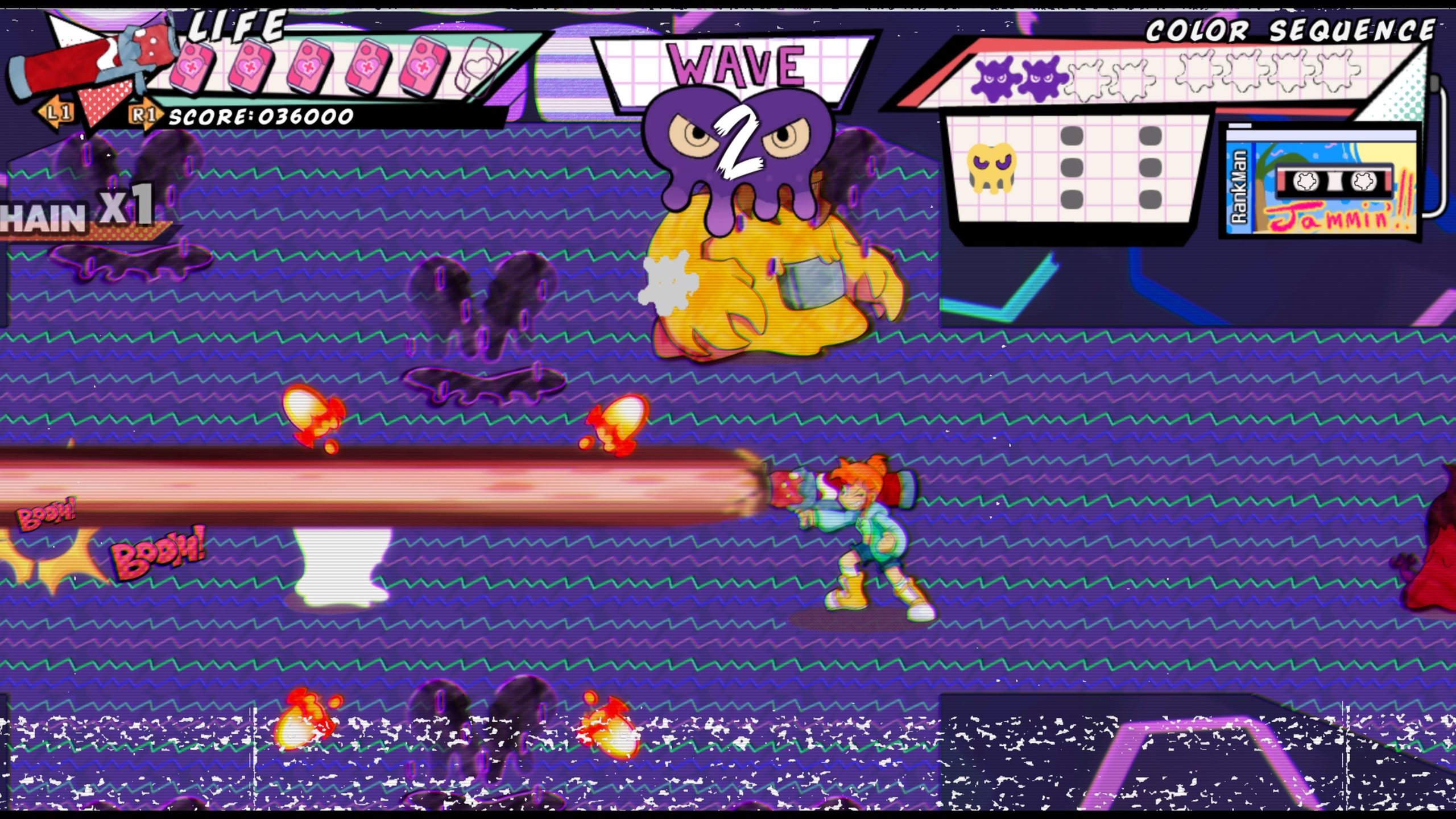
Story Slinger
PopSlinger introduces you to Ria, someone who’s trying to run away from the city as the world is getting overrun by the goo monsters. Gin is a spirit from another world who stops Ria from leaving by helping her out with gathering Popsouls? Which hold the ultimate power if you have all of them? Honestly, it was extremely forgettable. If the game’s not dumping exposition, it creates faux character challenges on whether or not you should be the hero.
I’m partially to blame for my vague, potentially inaccurate, retelling of the game’s story, but the game is so vague itself that I checked out when it came to the dialogue in between the levels. Characters are fully voice acted that range from ok to obnoxious and are often as wooden as how the game controls.
It does do a good job of bringing some of the ’90s vibes by being a colourful bombastic romp. Some Sailor Moon references thrown in there, reminding me of the days of Fox Kids – Totally Spies, Dragonball Z and Power Rangers all kind of ruminate in the aesthetics of this game.

StopSlinger
All in all, PopSlinger is on the lower side of average for me. The game didn’t take a whole bunch of my time to beat, the gameplay itself is questionable but simple enough to achieve that it’s not frustrating, and the story is struggling to stay in my memory – I last played it yesterday as of the time of this writing.
I do see the dev team’s ambition with this, most of the names across the acting/dev side are seen throughout its music and everything else, so a small close-knit team devised all of PopSlinger’s elements, which is awesome.
There aren’t a ton of songs, but they’ve written some catchy jams in there, which definitely elevates the so-so time I had playing it. Overall, Funky Can Creative’s passions are evident in PopSlinger, I just wish that passion went into something better executed.
PopSlinger is ambitiously flawed but endearing nonetheless. The lack of accessibility options paired with awkward and clunky gameplay dampens the otherwise inoffensive experience, but it’s a quick jaunt into nostalgia and has a great albeit small soundtrack.
PopSlinger is out 29th February 2024 for PlayStation 5 (review platform), PS4, Xbox Series X|S and Xbox One. Available now on Nintendo Switch and PC via Steam.
Developer: Funky Can Creative
Publisher: Artax Games
Disclaimer: In order to complete this review, we were provided with a promotional copy of the game. For our full review policy, please go here.
If you enjoyed this article or any more of our content, please consider our Patreon.
Make sure to follow Finger Guns on our social channels –Twitter, Facebook, Twitch, Spotify or Apple Podcasts – to keep up to date
